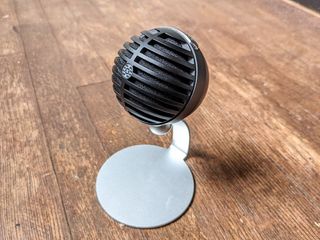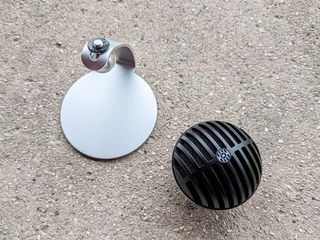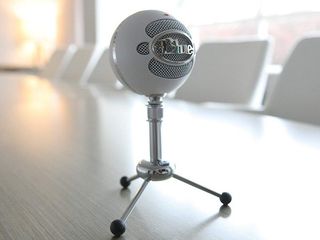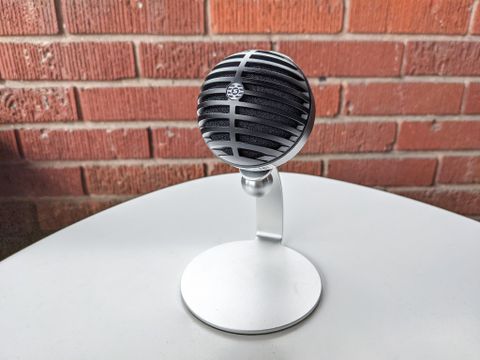Android Central Verdict
Bottom line: The MV5C is a compact USB microphone designed specifically for Zoom meetings, with built-in settings like compression and automatic EQ adjustments that ensure great sound quality with as little work as possible.
Pros
- +
Small, lightweight design
- +
Speech mode toggles handy optimizations
- +
Great sound relative to its price
- +
Headphone jack for audio monitoring
Cons
- -
Uses the dated Micro-USB
- -
Speech mode can't be customized
- -
No angle adjustment
Why you can trust Android Central
Shure is one of the most pedigreed names in the audio business, with a range of incredibly popular and instantly recognizable microphones, from the SM7B to the SM57 to the gorgeous Super 55 Deluxe. These models have been around for decades and have established Shure as an undeniable force in recording, but in more recent years, there's been an increasing demand for portable USB microphones — not so much for musicians looking to record their next album, but for podcasters, streamers, and voiceover artists who want to record audio without the need for expensive and bulky equipment like XLR interfaces and pre-amps.
Last winter, I reviewed the Shure MV7, calling it "the perfect podcasting microphone" thanks to its great sound, versatility, powerful app, and options for either USB or XLR output. It's essentially a more compact and modern SM7B, and I still use it for every recording of the Android Central Podcast — but even that microphone is larger than what most would considerable "portable," and requires some sort of mount like a boom arm to use properly.
That's where the Shure MV5C comes in.
Shure MV5C: Price and availability

The Shure MV5C was announced on October 27, 2020, and released the same day for $99 MSRP through a variety of retailers, including Amazon, Best Buy, B&H, and others. This microphone is currently available in a single color configuration with a black housing and a silver metal stand.
It's still a little too early for the microphone to have gone on any major sales, though Shure itself is already selling the MV5C at a $10 discount at $89.
Shure MV5C: Touring the hardware

The MV5C is a strikingly tiny microphone, fitting easily onto anyone's desk setup and just as easily tucking into a bag for quick travel. The hardware is made up of two components: the microphone itself, featuring a ball-shaped design with a flat back exposing its various ports; and the stand, a small, lightweight silver base made of metal with a soft, grippy pad on the bottom to keep it from moving around or scratching your desk.
The base attaches easily to the microphone with a small, circular thumbscrew. I love that you can assemble and disassemble the mic without the need for any tools, though for the sake of packing, I'd love it if the stand had been collapsible since its shape is a bit awkward to fit into a bag. Still, I like the retro design of the MV5C overall, and the built-in windscreen works surprisingly well without the need for an additional filter.
Quick setup for Zoom calls, and small enough to stay out of view from your webcam.
On the back is where all of the action is — which is to say, the ports and buttons. There's a 3.5mm headphone jack in the recessed cavity for monitoring audio input, and you can set your computer to route all outgoing audio through to your headphones, as well; this is generally how I've used the MV5C (and the MV7) for podcasting.
As with the MV7, there's a Micro-USB port on the back of the MV5C ... and also as with the MV7, I wish it had been a USB-C port instead. It's hard to imagine Shure is saving that much money by opting for an outdated port, but at the very least, you get cables ending in both USB-A and USB-C in the box, so you don't need to dust off your USB-C dongle to record audio on the go.

Along with the two ports, there are two buttons on the back of the MV5C: one for quickly muting and unmuting your audio and one for switching between modes. The MV5C features a dedicated Speech mode that automatically adjusts gain, compression, and EQ processing to improve your in-call audio for Zoom meetings and voiceovers, though you can just as easily disable it to record other types of audio.
Unlike the MV7 I reviewed before, the MV5C doesn't feature any specialized desktop software like ShurePlus MOTIV. Whether that's a good or bad thing will depend on how you look at the mic; this isn't intended to be a professional-grade microphone by any means, and adding complex software to the mix would only serve to scare off first-time users. Instead, the MV5C has great plug-and-play compatibility, and you can always tweak your own settings in a DAW if you choose to.
For quick reference, there are three status lights on the back of the MV5C, indicating settings like whether Speech mode is enabled or whether you're monitoring audio through the mic's headphone jack. A much more subtle hardware feature is the gain dial just below these status lights.
Shure MV5C: How does it sound?

The MV5C is heavily marketed towards people who need a better mic for meetings in today's work-from-home environment, but it works just as well for voiceovers or even musical performances. The built-in Speech mode instantly adds compression to up your audio levels and balance out the highest and lowest points in the waveform, tweaks settings like the EQ, and even adds a de-esser to reduce the unpleasant hiss of sharp "S" sounds.
For the best results, Shure recommends recording with the MV5C 12-18 inches from your mouth. There's a lot of bass response in the MV5C's audio, and that's only emphasized by the compression of Speech mode, though it's not so bass-heavy that it's a problem. I typically prefer a brighter sound, but I appreciate that the MV5C automatically applies so many of the settings that I typically add to my audio in Logic. Of course, I'd love some more flexibility — again, without an app of any kind to adjust the settings on the MV5C, you're stuck choosing between all or nothing.
Hayato Huseman · Shure MV5C test audio
One of my only complaints with Speech mode is how aggressive the de-esser is, often resulting in a muffled sound rather than soft, smoothly rounded out esses. Again, though, you can always stick with Flat mode by pressing the mode button on the back of the mic to record audio exactly how the MV5C hears it and then add your own settings later.
The MV5C definitely doesn't have the crisp, clear audio of its pricier sibling, the MV7, but that's to be expected for nearly a third of the price. More importantly, it's perfectly sufficient for the meetings, and video calls it's made for.
Shure MV5C: Competition

For as nice as the MV5C is, Blue has had a strong grip on the consumer audio space for some time now, and with good reason. The Blue Snowball is perhaps the MV5C's most direct competitor, with a similarly compact circular design and the option to change pickup patterns — effectively changing the directionality of the mic for, say, an in-person podcast for which you need to capture multiple people in a room with a single microphone. I think the MV5C sounds much better than the Snowball, but having multiple pickup patterns is a compelling feature, especially for $30 less than the MV5C at just $70.
For a bit more money, you could also pick up the mighty Blue Yeti. It's a much larger and heavier mic, but the Yeti has been a staple of podcasting, streaming, and voiceover work for years now, thanks to its four variable pickup patterns. You can choose to record audio from directly in front of the Yeti, from in front and behind, from the front and sides, or all around the mic with a single dial.
If portability is your primary need — maybe you're regularly traveling or working from coffee shops and need a microphone that's as mobile as you are — there are also options like the Samson Go, which tucks neatly into a pocket and mounts directly onto the top of your laptop. You won't get quite the same impressive sound quality as you would from the MV5C, but it'll certainly beat out the built-in mics on your computer.
Shure MV5C: Should you buy it?
You should buy this if ...
- You need an affordable and simple microphone for meetings with great, clear audio
- Portability is a factor, whether for traveling or simply working from different rooms
- You'd rather not fuss with settings like compression and EQ adjustments manually
You shouldn't buy this if...
- You like to tweak the settings on your microphone
- You want the low noise floor of an XLR mic
- You need the option of multiple pickup patterns for more flexibility
The Shure MV5C punches well above its weight in terms of raw audio quality, and its built-in Speech mode is a great way to instantly improve your sound for meetings and podcasts. I do wish there was the option to customize those Speech mode settings, either through an app or onboard controls, but I think this is a terrific overall microphone for working from home that won't overextend your budget or desk space.
4 out of 5
So long as you only need to record yourself and don't have a need for other pickup patterns, I'd take the MV5C over any of the alternatives from Blue and others around the same price point. Shure is a legendary brand for a reason, and this mic simply sounds better than a $100 microphone should. Put simply, this is one of the new best cheap USB microphones you can buy.
Hayato was a product reviewer and video editor for Android Central.


